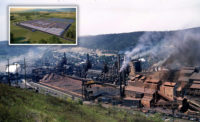Energy Construction
Canada's First Liquid Propane Export Site Will Build $980M Addition

Existing small liquid propane export terminal at the Prince Rupert, B.C., port is the site of planned 190-acre expansion for which the facility's Canadian-Dutch developer announced final investment decision,
Image courtesy of Alta Gas Ltd.
Canadian energy firm Alta Gas Ltd. and Dutch tank storage company Royal Vopak will build a $980.5 million liquefied petroleum gas (LPG) and bulk liquids terminal export terminal at the port of Prince Rupert, B.C., to boost shipments to Asian markets, the firms said.
Ridley Island Energy Export Facility, set to operate in late 2026, will be built on a 190-acre site adjacent to the existing 24-acre Ridley Island Propane Export Terminal operated by the two firms since 2019 on land leased from the Prince Rupert Port Authority. The final investment decision announcement late last month follows a five-year environmental review.
AltaGas COO Aaron Bishop stressed the proximity of the port, Canada's third largest after Cancouver and Montreal, to Asian countries. "With only 10 shipping days to the fastest growing demand markets in northeast Asia, [the export facility] has a significant structural advantage in delivering [liquid gasses] with the shortest shipping time globally," he noted.
According to Bishop, shipments from similar U.S. Gulf Coast terminals “have to get through the Panama Canal which we know is congested and can result in “24-day voyages from there.”
Currently, AltaGas delivers more than 19% of Japan's liquid propane imports and 13% of those by South Korea.
The new facility will be built and operated under the firms' “existing exclusive rights granted by the [port authority]” to develop LPG, methanol and other bulk liquids exports on Ridley Island, they said.
The project's first phase will deliver about 55,000 barrels per day of initial LPG export capacity, including propane and butane, and 600,000 barrels of storage capacity in tanks to be fabricated in Asian work yards with fewer weather related delays. The onshore tanks in Prince Rupert will be a first for Canada, where such storage tanks typically remain on transport vessels, said Bishop.
The new facility also includes an estimated $347-million project for a new dedicated jetty, 10 dual sided rail offloading slots and 25 kilometers of multi-track rail infrastructure. Marine general contractor Van Pile Driving has already completed the early stages of jetty construction while Calgary-based Gas Liquids Engineering performed front-end engineering design for the export facility. More than 95% of the site has been cleared.
According to Bishop, the project now is negotiating government incentives but indigenous support agreements are in place, which he said are expected to drive local economic benefits. In a related development, the Canada Infrastructure Bank recently reached financial close on a $109-million loan to the port authority for the first phase of CANXPORT, a new export logistics hub that will expand rail-to-container transloading at the Prince Rupert port.
But according to one report, a potential export terminal competitor has surfaced, with a plan submitted last year to the authority by Trigon Pacific Terminals, which seeks to convert part of its existing site space for liquid petroleum gas export. The plan, which the authority has so far rejected, now is in litigation. The developer, a former federally owned company, now is owned by two U.S. based private equity firms and two Canada First Nations.
Canadian politicians are also now eyeing executive and legislative steps to ban exports of thermal coal used for power, something the current government of Premier Pierre Trudeau promised earlier to do by 2030, but it is not clear if or how that action would affect LPG export.




